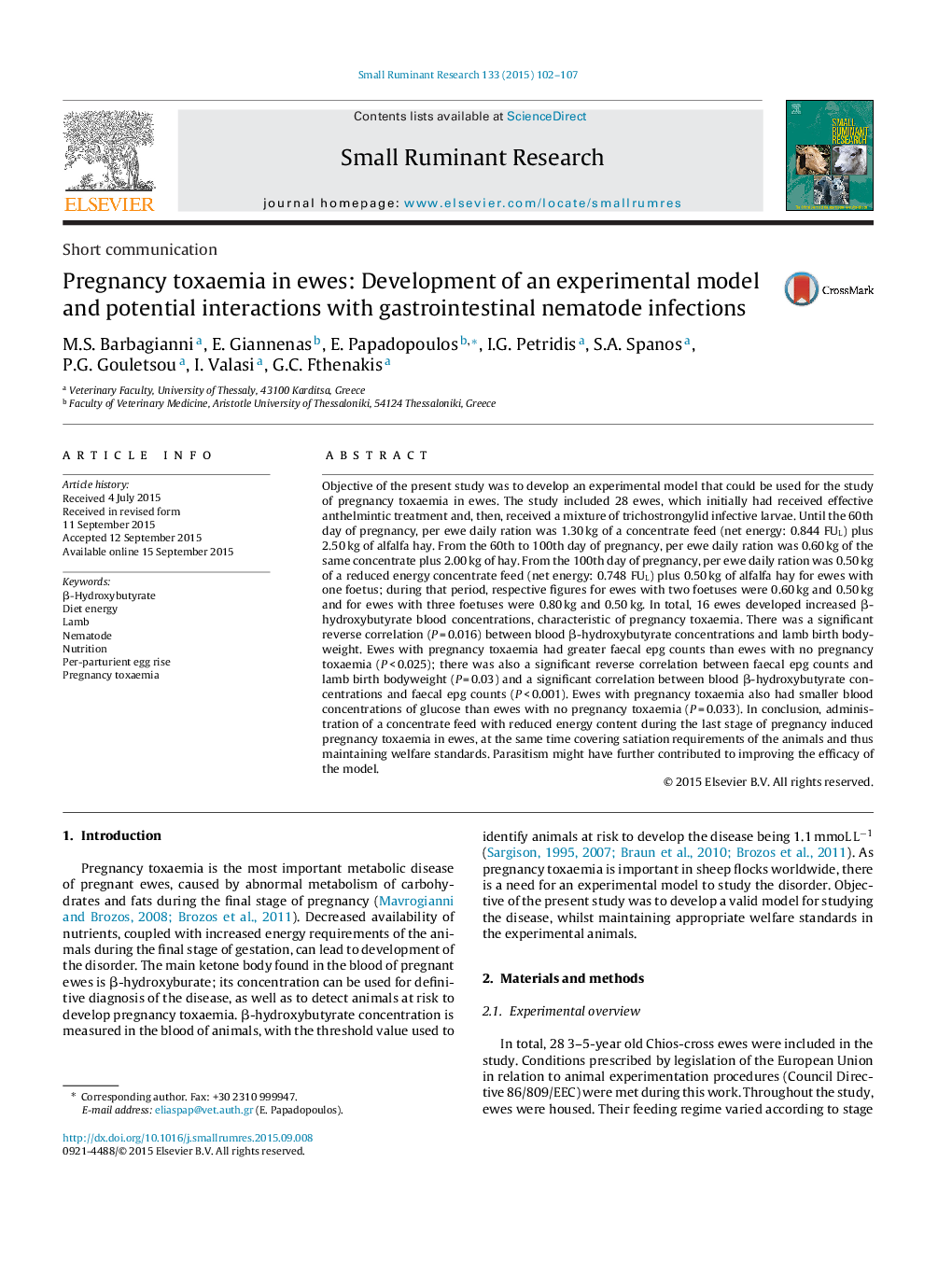| کد مقاله | کد نشریه | سال انتشار | مقاله انگلیسی | نسخه تمام متن |
|---|---|---|---|---|
| 2456828 | 1554359 | 2015 | 6 صفحه PDF | دانلود رایگان |
عنوان انگلیسی مقاله ISI
Pregnancy toxaemia in ewes: Development of an experimental model and potential interactions with gastrointestinal nematode infections
دانلود مقاله + سفارش ترجمه
دانلود مقاله ISI انگلیسی
رایگان برای ایرانیان
کلمات کلیدی
موضوعات مرتبط
علوم زیستی و بیوفناوری
علوم کشاورزی و بیولوژیک
علوم دامی و جانورشناسی
پیش نمایش صفحه اول مقاله

چکیده انگلیسی
Objective of the present study was to develop an experimental model that could be used for the study of pregnancy toxaemia in ewes. The study included 28 ewes, which initially had received effective anthelmintic treatment and, then, received a mixture of trichostrongylid infective larvae. Until the 60th day of pregnancy, per ewe daily ration was 1.30 kg of a concentrate feed (net energy: 0.844 FUL) plus 2.50 kg of alfalfa hay. From the 60th to 100th day of pregnancy, per ewe daily ration was 0.60 kg of the same concentrate plus 2.00 kg of hay. From the 100th day of pregnancy, per ewe daily ration was 0.50 kg of a reduced energy concentrate feed (net energy: 0.748 FUL) plus 0.50 kg of alfalfa hay for ewes with one foetus; during that period, respective figures for ewes with two foetuses were 0.60 kg and 0.50 kg and for ewes with three foetuses were 0.80 kg and 0.50 kg. In total, 16 ewes developed increased β-hydroxybutyrate blood concentrations, characteristic of pregnancy toxaemia. There was a significant reverse correlation (P = 0.016) between blood β-hydroxybutyrate concentrations and lamb birth bodyweight. Ewes with pregnancy toxaemia had greater faecal epg counts than ewes with no pregnancy toxaemia (P < 0.025); there was also a significant reverse correlation between faecal epg counts and lamb birth bodyweight (P = 0.03) and a significant correlation between blood β-hydroxybutyrate concentrations and faecal epg counts (P < 0.001). Ewes with pregnancy toxaemia also had smaller blood concentrations of glucose than ewes with no pregnancy toxaemia (P = 0.033). In conclusion, administration of a concentrate feed with reduced energy content during the last stage of pregnancy induced pregnancy toxaemia in ewes, at the same time covering satiation requirements of the animals and thus maintaining welfare standards. Parasitism might have further contributed to improving the efficacy of the model.
ناشر
Database: Elsevier - ScienceDirect (ساینس دایرکت)
Journal: Small Ruminant Research - Volume 133, December 2015, Pages 102-107
Journal: Small Ruminant Research - Volume 133, December 2015, Pages 102-107
نویسندگان
M.S. Barbagianni, E. Giannenas, E. Papadopoulos, I.G. Petridis, S.A. Spanos, P.G. Gouletsou, I. Valasi, G.C. Fthenakis,